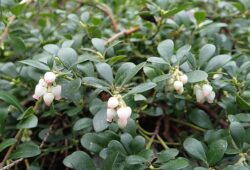In this article, we will discuss how to grow Arctostaphylos, an unusual member of the Ericaceae (the Heather) family, in containers. Arctostaphylos comes from the Greek words ‘Arkouda’ meaning ‘Bear’ and ‘Staphula’ meaning ‘Bunch of Grapes’. There are about 60 species of Arctostaphylos where some are prostrate shrubs whilst others are 6m tall trees.

These acid-loving plants make a great alternative to Callunas, Andromedas, Daboecias, Vaccinum and Gaultherias. Most of the species are evergreen (there the only one deciduous species known) and have small, oval, 1 to 2cm long, green leaves that are arranged spiralled around the stems. In early to mid-spring, white or pale pink bell-shaped flowers are borne in clusters of 2 to 20 on the tips.
The plant has no special features compared to other acid-loving plants mentioned above. It is grown as people like to grow them. You may want to buy it as an alternative to others often seen in the garden.
The flowers are followed by small berries that ripen in summer or autumn, with some berries of some species being edible. The leaves of some species may turn red or purplish in winter before turning green again in spring. The berries are attractive to the birds as they last throughout winter as the fruits are slow to rot.

The plants are native to North America, Europe and Asia. The shrubs are also wind and cool tolerant making them ideal shrubs to have in containers in the garden.
Find out how to grow this delightful shrub in Containers in this article.
GROWING ARCTOSTAPHYLOS IN CONTAINERS
Like Calluna, Pieris, Andromeda etc. it needs acidic soil to do well. First, choose a large container as possible that has plenty of drainage holes at the bottom. To the bottom of this container, add a 1cm layer of gravel to aid drainage further and on top of this add up to 5cm below the rim ericaceous compost.
Dig a hole at the centre of the container slightly bigger than the root ball it came in the original container. Place the plant in so that the top of the root ball is at the same level as the top surface of the compost. Backfill with the growing media so that is snuggly in, using more compost if necessary. Firm the plant in and water well.
THE BEST GROWING CONDITIONS
This is one plant that prefers full sun but can take partial shade if necessary. You will need to water once 5cm below the top surface of the compost feels dry to the touch, It is better to use rainwater as this will not introduce calcium or magnesium salts in hard water areas. Once the plant is established it will not need watering frequently but until then, water as recommended above.

Arctostaphylos prefers to grow in poor soil and so does not need fertilizing. Only fertilize if the plant is showing chlorosis or other signs of nutrient deficiencies.
Pruning is not necessary but in late winter, you can cut back vigorous growth to keep the plant in check.
To propagate, you can either use semi-ripe cuttings in summer or you can layer in the ground in autumn. You can remove rooted runners from the parent shrub and plant them in autumn.
PESTS AND DISEASES
The good news is that the plant will not suffer from any pests and diseases. This makes it an ideal plant for those that want to grow a plant that is maintenance-free and not attacked by anything.
VARIETIES TO GROW
The good news is that the red Bearberry (Arctostaphylos uva-ursi) which is a slender, ground-hugging plant with slender branches and green leathery leaves. It is a slow-growing shrub, only reaching a maximum height of 21cm but a spread of 1m. The pink-tipped white flowers appear in drooping clusters in spring and the red showy berries appear soon afterwards in autumn.
Other species you can find include is Arctostaphylos myrtifolia which is a red-barked shrub that reaches over a meter in height, the leaves are small, bright green and are coated with tiny glandular hairs and are rough in texture. The urn-shaped flowers are borne on red branches.

Arctostaphylos manzanita has bright, showy green, wedge-shaped and pointed leaves. On branches, small white flowers, 6mm long, cup-shaped are produced that dangle down. The berries that follow are white when new but turn increasingly red-brown as the season progress. The bark is cracked and reddish giving to its appeal. The shrub itself is quite tall and can easily grow to 3.5m tall. Often not suitable to be grown in containers.
Arctostaphylos nevadensis is a 0.5m short, mat-forming shrub that has larger branches than the other. The bark is often dull red and the twigs woolly. The leaves are bright green and shiny, with some hairs along the edges. The plant produces spherical clusters of urn-shaped white flowers, which are followed by spherical berries that are 7cm wide.
CONCLUSIONS
In this article, we have discussed how to grow the wonderful-looking shrub of Arctostaphylos in containers. They are generally easy to grow, easy to care for and are pests and diseases free. You have plenty of choice as to what variety or species to grow and they make an attractive alternative to the Pieris, Callunas or Ericas often seen in gardens.
If you have any questions or comments that you would like to make on growing Arctostaphylos in containers, please do so in the comment box below.
Happy Arctostaphylos growing.
